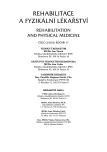The Influence of Cyclist Step on Locomotor System
Authors:
B. Kračmar; R. Bačáková; V. Hojka
Authors‘ workplace:
Katedra sportů v přírodě FTVS UK, Praha
Published in:
Rehabil. fyz. Lék., 17, 2010, No. 3, pp. 107-112.
Category:
Original Papers
Overview
The cyclist step is an important element of locomotor activity recommended as a post-rehabilitation motion regimen. Free bipedal walking is the decisive motion stereotype of the pelvic bundle, being the result of phylogenesis and human postural motion ontogenesis. This obviously does not apply for the cyclist step, where the power is generated on an artificially constructed machine. The objective of the investigation, performed by means of surface polyelectromyography in the field, was to observe selected muscles in riding up the hill while seated. The results indicate some changes in involvement of the observed muscles and confirm relevance of the recommended cyclist step in riding in the saddle during post-rehabilitation motion regimen.
Key words:
cyclist step, riding at the saddle, electromyography
Sources
1. Battista, R. A., Foster, C., Andrew, J., Wright, G., Lucia, A., Porcari, J. P.: Physiologic responses during indoor cycling. J. Strength Cond. Res., 23, 2008, č. 9, s. 2425-2429.
2. DE LUCA, C. J.: The use of surface electromyography in biomechanics, [on-line] 1993, [cit. 1. 1. 2009]. Dostupné na www: http://delsys.com.
3. Dickinson, S.: The efficiency of bicycle-pedalling, as affected by speed and load. Journal of Strength and Conditioning Research, 22, 2008, č. 4, s. 1236-1241.
4. Frank, L. D.: Land use and transportation interaction: implications for public health and quality of life. J. Plann. Education Res., 2000, č. 20, s. 6-22.
5. Janda, V., Poláková, Z., Véle, F.: Funkce hybného systému. Praha, Státní zdravotnické nakladatelství, 1996.
6. JARVIK, E.: Basic structure and evolution of vertebrates. New York, Academic Press, 1980, s. 163-242.
7. Massaad, F., MLejeune, T., Detrembleur, CH.: The up and down bobbing of human walking: a compromise between muscle work and efficiency. J. Physiol., 582, 2007, č. 2, s. 789-799.
8. KRAČMAR, B.: Vliv cyklistiky na pohybovou soustavu. Rehabil. fyz. Lék., 12, 2006, č. 1, s. 27-33.
9. Kračmar, B., Tlašková, P. Mrůzková, M.: Geneticky determinovaný pohybový program při zapojení svalů v oblasti ramenního pletence při nordic walking. Rehabilitácia, 45, 2008, č. 2, s. 67-73.
10. MERLETTI, R., PARKER, P.: Electromyography. Physiology, engineering, and noninvasive applications. John Wiley & Sons, Inc., Hoboken, New Persey, 2004.
11. PATTERSON, R. P., MORENO, M. I.: Bicycle pedalling forces as a function of pedalling rate and power output. J. Physiol., 67, 1990, č. 3, s. 242-255.
12. ROMER, A. S.: Vertebrate paleontology. Chicago and London: The University of Chicago Press, 1967, s. 217-235.
13. SHUBIN, N. H., ALBERCH, P.: A morphogenetic approach to the origin and basic organisation of the tetrapod limb. Evolutionary Biology, 20, 1986, č. 2, s. 319-387.
14. Vacková, P.: Fylogenetické souvislosti sportovní lokomoce. Diplomová práce. Praha, Univerzita Karlova v Praze, Fakulta tělesné výchovy a sportu, 2004.
15. Vančata, V.: Fylogeneze člověka a jeho předků. In: Švecová M. a kolektiv, Nové směry v biologických oborech a jejich speciálních didaktikách. Praha, Karolinum, 2002, s . 47-84.
16. Vařeka, I.: Dynamický model „tříbodové“ opory nohy. Rehabilitácia, 41, 2004, č. 3, s. 131-136.
17. VÉLE, F.: Kineziologie. Praha, Triton, 2006.
18. VOJTA, V., Peters, A.: Vojtův princip. Praha, Grada Publishing, 1995.
19. VYSTRČILOVÁ, M., KRAČMAR, B., KOZELSKÝ, D., ŠKOPEK, M.: Dětské plazení jako základní forma lidské lokomoce prostřednictvím pletence ramenního. In: Sb.: Tělesná výchova sport mládeže v biologickém, psychologickém, sociálním a didaktickém kontextu Ed.: Mužík, V., Dobrý, L., Süss, V., Brno, Masarykova univerzita, 2008, s. 65-79.
20. Walker, A. C., Leakey, R. E.: The nariokotome homo erectus skeleton. Cambridge (Massachusetts), Harvard University Press, 1993, s. 128-136.
Labels
Physiotherapist, university degree Rehabilitation Sports medicineArticle was published in
Rehabilitation & Physical Medicine

2010 Issue 3
Most read in this issue
- Tietze’s Syndrome Versus Multiple Myeloma
- Clinical Study of High-induction Electromagnetic Stimulator SALUS Talent
- Rehabilitation in Orofacial Region in Cases of Central Paresis of Facial Nerve
- Application of Electrotherapeutic Currents of the TENS Type in Physiotherapy
